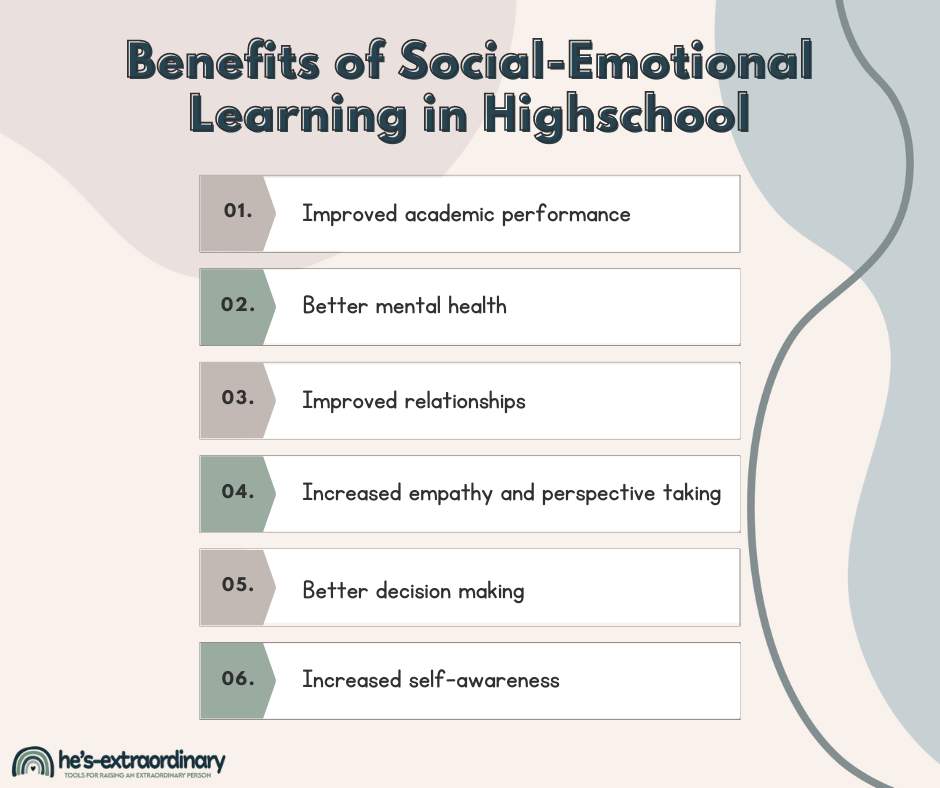The Benefits of SEL in High School & How to Implement It
What’s inside this article: A brief look at what social-emotional learning is, the benefits of SEL in high school students, and five tips for successfully implementing SEL into high school classrooms.
The teenage years can be challenging for students. They are going through physical and emotional changes while navigating a complex social landscape.
For many students, high school is when they develop their sense of self, establish more complex relationships with peers and adults, discover their sexuality, and explore their interests and passions.
It is also a time when they’re exposed to new ideas, concepts, and perspectives outside of the home/family structure that can shape their values and beliefs.
One key aspect of high school education that can help students navigate these challenges and build healthy relationships is social-emotional learning or SEL for short.
What is SEL?
Social-Emotional Learning is the process of learning and applying the skills necessary to manage emotions, have self-awareness and social awareness, and show empathy.
SEL is important for developing and maintaining positive relationships, decision-making skills, develop perspective-taking skills, and building emotional intelligence.
Engaging in social-emotional learning from early childhood all the way into adulthood is critical.
You can read more about what SEL is and the components of social-emotional learning here.
The Benefits of SEL in High School
Social-emotional learning is crucial for high school students because it helps them develop the skills and competencies needed to navigate adolescence’s complex social and emotional landscape.
Do you remember what it was like being a teenager? From first kisses to first break ups, new friendships, forming long-term life goals, and figuring out who you are, all while facing academic pressures, peer pressure, and other stressors.
There are so many new social situations and intense emotions to try to grasp. It’s a lot for a developing brain to take on.
Social-emotional learning can help high school students in many ways. Here are some of the benefits of SEL for high school students:
Improved academic performance:
Social-emotional learning in high school improves academic performance by helping students develop the skills and competencies needed to manage their emotions, set goals, and work effectively with others.
Students with a strong foundation in SEL can focus on their academic work, handle stress and challenges, and work collaboratively with peers and teachers.
Research has shown that students who participate in SEL programs tend to have better academic performance, higher grades, and higher graduation rates than their peers who do not participate in such programs. Thus, SEL provides a solid foundation for academic success in high school and beyond.
Better mental health:
Social-emotional learning in high school leads to better mental health because it helps teens develop coping skills, emotional regulation, and problem-solving skills.
When teens have a strong foundation in SEL, they are better able to manage their emotions, handle stress, and cope with the challenges of adolescence. They are also better equipped to identify and seek help for mental health issues when they arise.
Research has shown that high school students who participate in SEL programs tend to have lower levels of anxiety, depression, and other mental health issues than their peers who do not participate in such programs.
Implementing SEL in high school protects against mental health problems and promotes overall well-being in high school students.
Improved relationships:
When teens have a strong foundation in SEL, they are better equipped to communicate effectively, listen actively, and build positive relationships with their peers, teachers, and family members.
SEL also helps teens develop empathy and perspective-taking skills, which can help them understand and appreciate the perspectives of others, leading to more positive and fulfilling relationships.
Research shows that students who participate in SEL programs tend to have better relationships with their peers and are less likely to engage in risky behaviors that could damage relationships.
Increased empathy and perspective-taking:
SEL in high school leads to improved empathy and perspective-taking by teaching students how to understand and appreciate the perspectives of others.
Teens who participate in SEL programs are better able to recognize and understand the emotions and feelings of others, leading to increased empathy. SEL also teaches students how to take the perspective of others, which involves putting themselves in someone else’s shoes and understanding their experiences and point of view.
Better decision-making:
Social-emotional learning programs in high school lead to better decision-making skills by helping students develop critical thinking and problem-solving skills.
SEL teaches students to evaluate situations, consider alternatives, and make thoughtful decisions based on their values and goals.
SEL also helps students develop self-awareness, self-regulation, and responsible decision-making skills, which can help them navigate complex social situations and make positive choices.
Increased self-awareness:
Social-emotional learning increases self-awareness by teaching students to recognize and understand their own emotions, thoughts, and behaviors.
SEL programs often include activities and exercises that encourage students to reflect on their experiences, identify their emotions, and consider how their thoughts and feelings influence their behavior.
By developing self-awareness, students can learn to regulate their emotions and respond more effectively to social situations. SEL also helps students identify their strengths and weaknesses, set goals, and develop a positive self-image, which can boost their self-esteem and resilience.
By promoting self-awareness, SEL provides a foundation for emotional and social growth and can help students develop a stronger sense of self as they navigate the challenges of adolescence.

Overall, social-emotional learning is essential for high school students because it can help them develop the skills and competencies needed to succeed in school and in life.
By providing opportunities for students to learn and practice these skills, educators can help them navigate the challenges of adolescence and develop the skills they need to thrive.
Implementing SEL in High School
There are several strategies that teachers can use to integrate SEL into their classrooms effectively.
Here are some tips for implementing SEL in high school:
Build a Positive Classroom Climate:
Creating a positive classroom climate is essential for SEL. Students need to feel safe, valued, and respected in order to engage in social-emotional learning. Teachers can create a positive classroom climate by setting clear expectations, recognizing students for positive behavior, and providing opportunities for student voice and choice.
Integrate SEL into Academics:
One of the best ways to integrate SEL into high school is to incorporate it into academics. Teachers can use SEL-themed texts, projects, and discussions to help students develop their social-emotional skills while also meeting academic standards.
Provide Opportunities for Student Reflection:
Reflection is an essential component of social-emotional learning. Teachers can provide opportunities for students to reflect on their emotions, behavior, and relationships. They can use journal prompts, discussion questions, or other reflective activities to help students process their experiences and develop their self-awareness.
Use Evidence-Based Practices:
Using evidence-based practices is essential for effective SEL instruction. Teachers can use research-based strategies such as role-playing, cooperative learning, and problem-solving to help students develop their social-emotional skills.
Involve Families and Communities:
Involving families and communities in SEL can help create a more holistic approach to social-emotional learning. Teachers can involve families and communities by hosting parent-teacher conferences, providing resources for families, and collaborating with community partners.
Social-emotional learning is a critical component of high school education. It can help students develop the skills and competencies needed to manage their emotions, build healthy relationships, and make responsible decisions.
Teachers can implement SEL effectively by building a positive classroom climate, integrating SEL into academics, providing opportunities for reflection, using evidence-based practices, and involving families and communities.
By doing so, they can help students develop the skills they need to succeed in school and in life.

